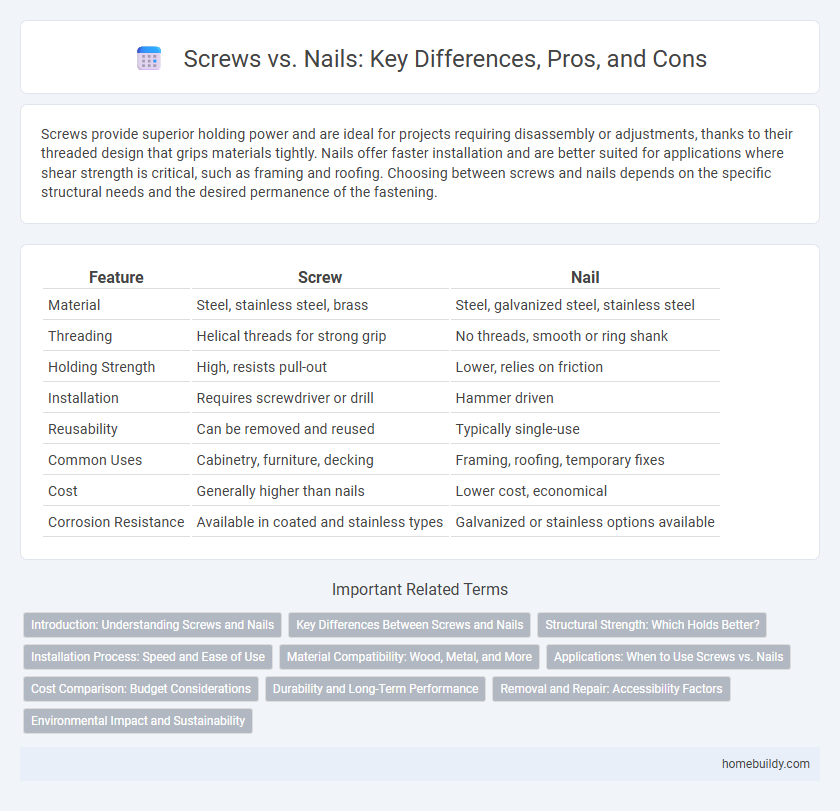Screws provide superior holding power and are ideal for projects requiring disassembly or adjustments, thanks to their threaded design that grips materials tightly. Nails offer faster installation and are better suited for applications where shear strength is critical, such as framing and roofing. Choosing between screws and nails depends on the specific structural needs and the desired permanence of the fastening.
Table of Comparison
| Feature | Screw | Nail |
|---|---|---|
| Material | Steel, stainless steel, brass | Steel, galvanized steel, stainless steel |
| Threading | Helical threads for strong grip | No threads, smooth or ring shank |
| Holding Strength | High, resists pull-out | Lower, relies on friction |
| Installation | Requires screwdriver or drill | Hammer driven |
| Reusability | Can be removed and reused | Typically single-use |
| Common Uses | Cabinetry, furniture, decking | Framing, roofing, temporary fixes |
| Cost | Generally higher than nails | Lower cost, economical |
| Corrosion Resistance | Available in coated and stainless types | Galvanized or stainless options available |
Introduction: Understanding Screws and Nails
Screws and nails serve as essential fasteners in construction and woodworking, each offering unique features tailored to specific applications. Screws provide strong holding power due to their threaded design, making them ideal for projects requiring durability and precision. Nails, featuring a smooth shank, are commonly used for quick assembly and framing where speed is prioritized over holding strength.
Key Differences Between Screws and Nails
Screws feature helical threads that provide strong holding power by gripping into materials, while nails rely on friction and shear strength for fastening. Screws are typically used when disassembly or precise alignment is needed, whereas nails are favored for quick, high-volume applications like framing. The choice between screws and nails impacts structural stability, with screws offering superior withdrawal resistance compared to nails.
Structural Strength: Which Holds Better?
Screws provide superior structural strength compared to nails due to their threaded design, which allows for greater holding power and resistance to withdrawal forces. Nails are more prone to loosening under stress and vibrations, making screws the preferred choice for applications requiring long-lasting, secure connections. Wood screws, in particular, excel in framing and load-bearing tasks where durability and tight fastening are critical.
Installation Process: Speed and Ease of Use
Screws require pre-drilling or driving with a screwdriver or drill, offering precise control but generally taking more time to install compared to nails. Nails can be quickly hammered or nailed with a pneumatic nail gun, making them faster and easier to use for large projects or framing. The installation process of nails is typically more straightforward, while screws provide stronger, longer-lasting holds in most materials.
Material Compatibility: Wood, Metal, and More
Screws offer superior material compatibility across wood, metal, and composite materials due to their threaded design, which provides stronger grip and resistance to pull-out. Nails perform well in wood but lack the holding power needed for metal or harder surfaces, making screws the preferred fastener for mixed-material projects requiring durability. Selecting screws with corrosion-resistant coatings ensures longevity in varied environments, enhancing performance in outdoor or high-moisture applications.
Applications: When to Use Screws vs. Nails
Screws provide superior holding strength and are ideal for applications requiring precision and durability, such as cabinetry, furniture assembly, and structural woodworking. Nails are preferred for faster installation in tasks like framing, roofing, and sheathing where shear strength and flexibility matter more than pull-out resistance. Choosing screws over nails enhances joint stability in load-bearing projects, while nails excel in quick, large-scale construction settings.
Cost Comparison: Budget Considerations
Screws generally cost more than nails due to their complex manufacturing process and enhanced holding power, making them a pricier choice for fastening projects. Nails are more budget-friendly, especially for large-scale tasks requiring volume, as they come in bulk at lower prices per unit. When considering cost-effectiveness, nails offer immediate savings whereas screws provide long-term value through durability and reduced maintenance expenses.
Durability and Long-Term Performance
Screws offer superior durability and long-term performance compared to nails due to their threaded design, which provides greater holding power and resistance to loosening under stress or vibration. The metal composition of screws typically includes corrosion-resistant coatings such as zinc or stainless steel, enhancing longevity in outdoor or high-moisture environments. In contrast, nails, while faster to install, are more prone to bending, pulling out, and corrosion, making them less reliable for applications requiring sustained structural integrity.
Removal and Repair: Accessibility Factors
Screws offer superior removal and repair accessibility due to their threaded design, enabling easy unscrewing without damaging surrounding materials. Nails, driven in with force, often require prying or cutting for removal, which can compromise the integrity of the material and complicate repairs. The choice between screws and nails significantly impacts maintenance efficiency and preservation of structural components.
Environmental Impact and Sustainability
Screws generally offer greater environmental sustainability than nails due to their reusability and superior holding power, reducing material waste by minimizing the need for replacements. Nails, often made from lower-grade steel, tend to corrode faster and are less reusable, increasing environmental impact through frequent disposal and resource consumption. Choosing corrosion-resistant screws made from recycled materials further enhances durability and reduces ecological footprint in construction projects.
Screw vs Nail Infographic

 homebuildy.com
homebuildy.com